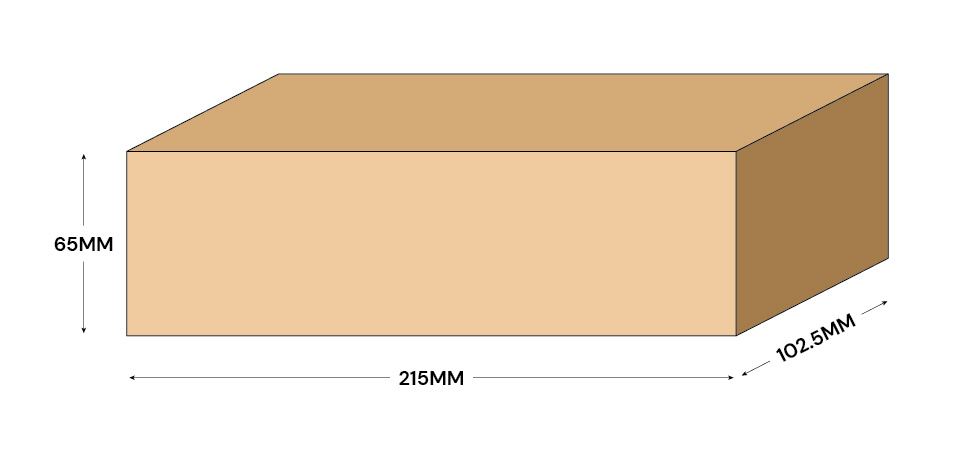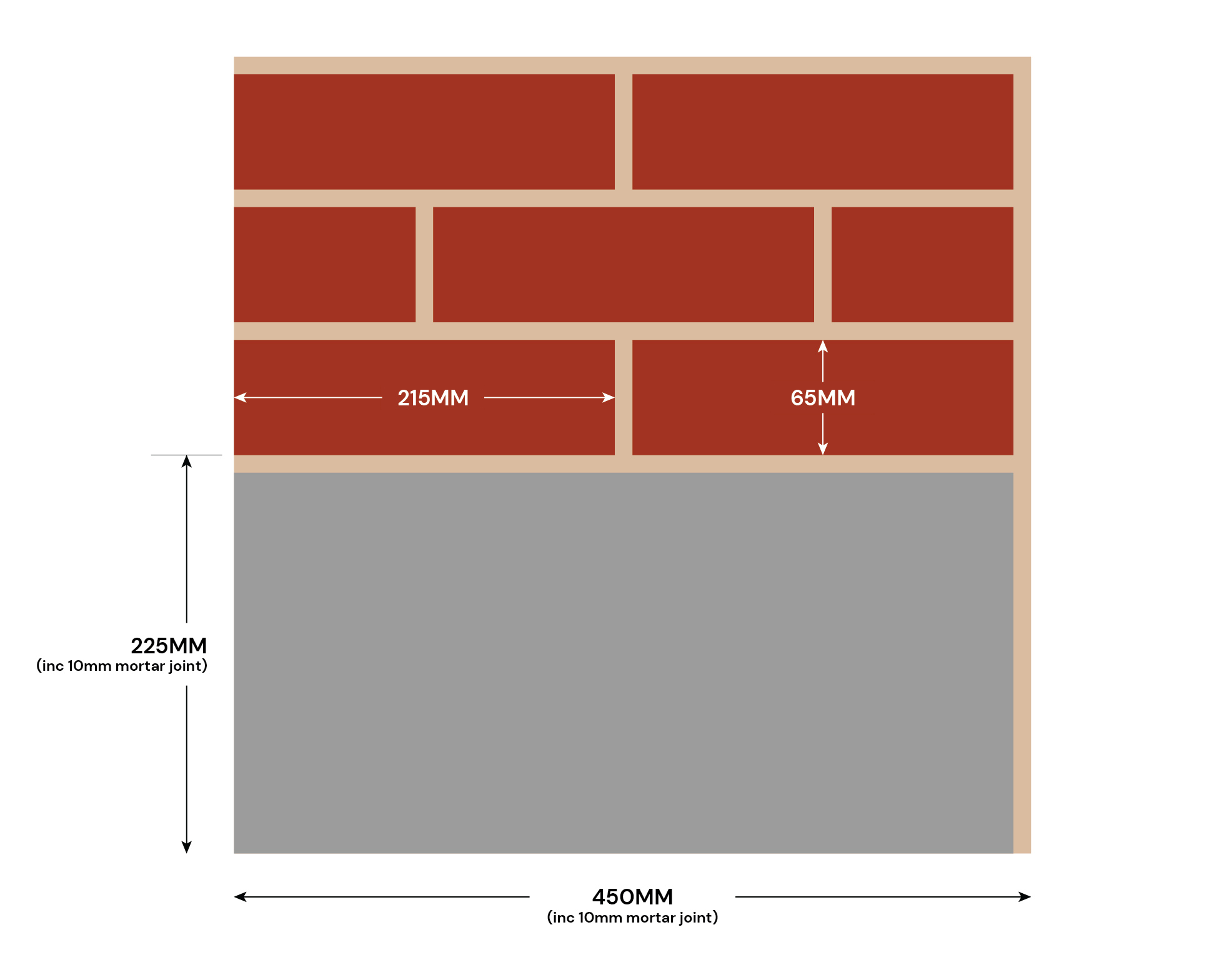Looking for Brick Slips for facade systems?
Visit our dedicated website.Looking for Brick Slips for facade systems?
Visit our dedicated website.When you’re designing with bricks, size matters.
We get it, understanding brick sizes and choosing the right one can be a bit of a minefield.
To save you a headache, we’re keeping this simple and giving you answers to questions you have about standard brick dimensions. We’ll cover sizes, coverage calculations and answer common questions to help you navigate your building project.
The standard brick size in the UK is 215mm (length) x 102.5mm (width) x 65mm (height).
When laid with a standard 10mm mortar joint, the ‘working size’ used by builders becomes 225mm (length) x 112.5mm (width) x 75mm (height).

This is known as metric size and was originally introduced in January 1970, specified in the British Standard BS 3921.
That standard is now superseded by the BS EN 771-1 European standard for clay masonry units, but the size remains the same.
Since 1970, most new properties have been built using metric size bricks.
Though this is the modern standard, there are instances where the standard size can’t be used, or isn’t suitable.
To keep it simple, bricks that deviate away from this size are usually known as imperial size, and those that are very long and thin are known as long format or linear bricks.
The below table gives you a quick guide to a range of sizes commonly available from various suppliers/manufacturers and reclaim brick yards.
| Size in Millimetres | Size in Inches (rounded) | Size Category |
| 215 x 102.5 x 65mm | 8½ x 4 x 2½” | Metric size |
| 215 x 102.5 x 73mm | 8½ x 4 x 3” | Hybrid size (metric with imperial height) |
| 228 x 108 x 68mm | 9 x 4¼ x 2¾” | Imperial size |
| 230 x 110 x 68mm | 9 x 4¼ x 2¾” | Imperial size |
| 228 x 108 x 73mm | 9 x 4¼ x 3” | Imperial size |
| 230 x 110 x 73mm | 9 x 4¼ x 3” | Imperial size |
| 228 x 108 x 75mm | 9 x 4¼ x 3” | Imperial size |
| 230 x 110 x 75mm | 9 x 4¼ x 3” | Imperial size |
| 228 x 110 x 80mm | 9 x 4¼ x 3¼” | Imperial size |
Linear bricks sizes vary depending on the supplier so aren’t included here, but they’ll usually be over 240mm in length and between 40-60mm in height.
Here’s a full guide on imperial size bricks if you’d like to delve into this further.
There is a simple answer to this question, but you’ll need to know whether the wall you’re building or extending is a single layer (known as half brick or single skin) or double layer (known as full brick or double skin).
Generally, modern homes have a single layer of facing bricks and older properties were built with a double layer. If you’re not sure, check with your architect or builder.
For a single layer/half brick wall, you will need 60 metric bricks per square metre.
For a double layer/full brick wall, you will need 120 metric bricks per square metre.
You will need to add allowance for wastage due to on-site cuts and breakages, this is usually between 5-10%.
To save you doing the calculations yourself, use this handy brick calculator tool.
There’s no stupid question when it comes to brick sizes. Let’s go through a few of the most common.
What size bricks you need simply depends on what you’re building.
Use metric size bricks (215 x 102.5 x 65mm).
The only reason you’d stray from this size is if you’re going for a different aesthetic look using linear/long format bricks.
Extending or renovating a property?
You’ll probably need an imperial size.
You’ll need to check the size of the bricks you’re matching up to.
As a general guide, if the property was built before 1970 there’s a good chance they’re imperial.
After? You’re more likely to need metrics.
Several brick suppliers, including us, offer a free brick matching service if you get stuck trying to find the right bricks.
The standard metric brick size was introduced to ensure consistency across the UK building industry.
Architects and designers can build to exact specifications and builders can accurately estimate costs of bricks, blocks and other materials. There’s no worry of materials from different suppliers not fitting together and it lessens wastage.
Standard concrete block sizes are intentionally sized to be compatible with metric size bricks.
1 single course (row) of blocks and mortar is the same height as 3 courses (rows) of bricks and mortar.

For modern cavity walls, this 1 to 3 ratio allows cavity wall ties to be laid perfectly straight across mortar joints, creating a secure structure.
The thickness of a wall depends on how many layers (also called a skin) of bricks it was/will be built with.
Also called a single layer or half brick wall.
Wall thickness is the same as the width of one standard size brick – 102.5mm
Requires 60 metric bricks per square metre (1m²)
Often used for garden walls and garages.
Also called a double layer or full brick wall
Wall thickness is the same as the length of one standard size brick – 215mm
(or two brick widths and a mortar joint: 102.5mm + 102.5mm + 10mm mortar joint = 215mm)
Requires 120 metric bricks per square metre (1m²)
Often seen in period properties when renovating and/or extending.
Similar to a single skin wall, with a skin/layer of concrete blocks behind it.
Calculated the same way as a single skin wall – 102.5mm
The modern standard for all new build homes.
Modern engineering bricks are manufactured to the standard UK metric dimensions of 215 x 102.5 x 65mm.
This allows them to integrate easily with facing bricks, especially for use in damp proof courses (DPC) or foundation work.
Now you’re armed with an understanding of the standard UK brick size, you’re ready to explore brick options that could work for you.
There are lots of suppliers you can choose from, but to start you off, if you’re tempted by traditional-style metric bricks we have a wide selection you can browse.
We have reds, oranges, yellows and custom blends, with many also available in weathered or aged options for an authentic reclaimed look.
And if you’re struggling with a match for an older property… put the pressure on us instead and take advantage of our free brick matching service.